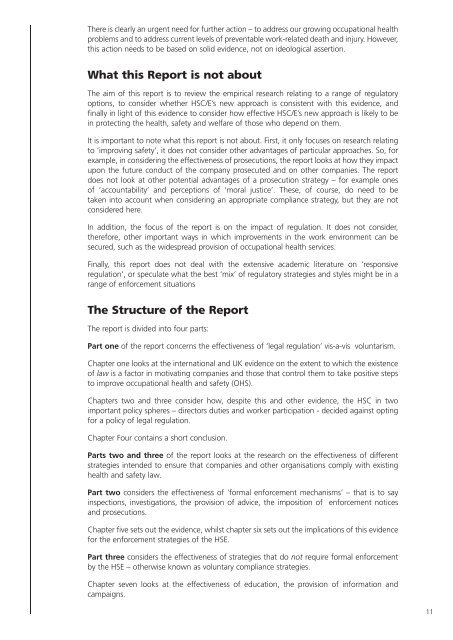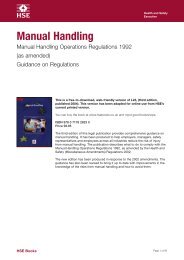Making Companies Safe - what works? (CCA ... - Unite the Union
Making Companies Safe - what works? (CCA ... - Unite the Union
Making Companies Safe - what works? (CCA ... - Unite the Union
You also want an ePaper? Increase the reach of your titles
YUMPU automatically turns print PDFs into web optimized ePapers that Google loves.
There is clearly an urgent need for fur<strong>the</strong>r action – to address our growing occupational health<br />
problems and to address current levels of preventable work-related death and injury. However,<br />
this action needs to be based on solid evidence, not on ideological assertion.<br />
What this Report is not about<br />
The aim of this report is to review <strong>the</strong> empirical research relating to a range of regulatory<br />
options, to consider whe<strong>the</strong>r HSC/E’s new approach is consistent with this evidence, and<br />
finally in light of this evidence to consider how effective HSC/E’s new approach is likely to be<br />
in protecting <strong>the</strong> health, safety and welfare of those who depend on <strong>the</strong>m.<br />
It is important to note <strong>what</strong> this report is not about. First, it only focuses on research relating<br />
to ‘improving safety’, it does not consider o<strong>the</strong>r advantages of particular approaches. So, for<br />
example, in considering <strong>the</strong> effectiveness of prosecutions, <strong>the</strong> report looks at how <strong>the</strong>y impact<br />
upon <strong>the</strong> future conduct of <strong>the</strong> company prosecuted and on o<strong>the</strong>r companies. The report<br />
does not look at o<strong>the</strong>r potential advantages of a prosecution strategy – for example ones<br />
of ‘accountability’ and perceptions of ‘moral justice’. These, of course, do need to be<br />
taken into account when considering an appropriate compliance strategy, but <strong>the</strong>y are not<br />
considered here.<br />
In addition, <strong>the</strong> focus of <strong>the</strong> report is on <strong>the</strong> impact of regulation. It does not consider,<br />
<strong>the</strong>refore, o<strong>the</strong>r important ways in which improvements in <strong>the</strong> work environment can be<br />
secured, such as <strong>the</strong> widespread provision of occupational health services.<br />
Finally, this report does not deal with <strong>the</strong> extensive academic literature on ‘responsive<br />
regulation’, or speculate <strong>what</strong> <strong>the</strong> best ‘mix’ of regulatory strategies and styles might be in a<br />
range of enforcement situations<br />
The Structure of <strong>the</strong> Report<br />
The report is divided into four parts:<br />
Part one of <strong>the</strong> report concerns <strong>the</strong> effectiveness of ‘legal regulation’ vis-a-vis voluntarism.<br />
Chapter one looks at <strong>the</strong> international and UK evidence on <strong>the</strong> extent to which <strong>the</strong> existence<br />
of law is a factor in motivating companies and those that control <strong>the</strong>m to take positive steps<br />
to improve occupational health and safety (OHS).<br />
Chapters two and three consider how, despite this and o<strong>the</strong>r evidence, <strong>the</strong> HSC in two<br />
important policy spheres – directors duties and worker participation - decided against opting<br />
for a policy of legal regulation.<br />
Chapter Four contains a short conclusion.<br />
Parts two and three of <strong>the</strong> report looks at <strong>the</strong> research on <strong>the</strong> effectiveness of different<br />
strategies intended to ensure that companies and o<strong>the</strong>r organisations comply with existing<br />
health and safety law.<br />
Part two considers <strong>the</strong> effectiveness of ‘formal enforcement mechanisms’ – that is to say<br />
inspections, investigations, <strong>the</strong> provision of advice, <strong>the</strong> imposition of enforcement notices<br />
and prosecutions.<br />
Chapter five sets out <strong>the</strong> evidence, whilst chapter six sets out <strong>the</strong> implications of this evidence<br />
for <strong>the</strong> enforcement strategies of <strong>the</strong> HSE.<br />
Part three considers <strong>the</strong> effectiveness of strategies that do not require formal enforcement<br />
by <strong>the</strong> HSE – o<strong>the</strong>rwise known as voluntary compliance strategies.<br />
Chapter seven looks at <strong>the</strong> effectiveness of education, <strong>the</strong> provision of information and<br />
campaigns.<br />
11
















